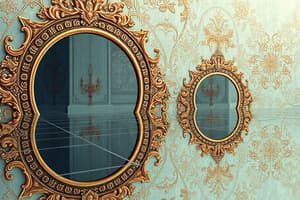Podcast
Questions and Answers
Why does a wet asphalt road at night cause glare from oncoming headlights?
Why does a wet asphalt road at night cause glare from oncoming headlights?
- The headlights are more intense at night.
- The rainwater diffuses the light, creating a broader, less intense reflection.
- The water fills the rough surface, creating a smoother surface for specular reflection. (correct)
- The rough asphalt absorbs the light, causing glare.
What distinguishes a real image from a virtual image?
What distinguishes a real image from a virtual image?
- Real images are formed by actual convergence of light rays, while virtual images appear to converge when traced backward. (correct)
- Virtual images are always larger than the object.
- Real images are always upright, while virtual images are inverted.
- Real images can only be formed by plane mirrors.
Which of the following is a characteristic of an image formed by a plane mirror?
Which of the following is a characteristic of an image formed by a plane mirror?
- The image is virtual, erect, and laterally inverted. (correct)
- The image is real, erect, and smaller than the object.
- The image is real and inverted.
- The image is virtual and magnified.
How does the position of an object relative to a concave mirror's focal point and center of curvature affect the image formed?
How does the position of an object relative to a concave mirror's focal point and center of curvature affect the image formed?
Which type of mirror is commonly used in security mirrors to provide a wide field of view?
Which type of mirror is commonly used in security mirrors to provide a wide field of view?
What property of light is responsible for the formation of a rainbow?
What property of light is responsible for the formation of a rainbow?
Why is red light used in photographic darkrooms?
Why is red light used in photographic darkrooms?
Which of the following explains why the sky appears blue?
Which of the following explains why the sky appears blue?
How does the wavelength of light relate to its energy?
How does the wavelength of light relate to its energy?
Why are clouds white?
Why are clouds white?
What happens to light when it travels from air into water?
What happens to light when it travels from air into water?
What is the relationship between the angle of incidence and the angle of reflection when light strikes a surface?
What is the relationship between the angle of incidence and the angle of reflection when light strikes a surface?
Which phenomenon explains why objects appear to be different colors?
Which phenomenon explains why objects appear to be different colors?
What causes a secondary rainbow to form, and how does it differ from a primary rainbow?
What causes a secondary rainbow to form, and how does it differ from a primary rainbow?
What is 'dispersion' in the context of light?
What is 'dispersion' in the context of light?
Which optical phenomenon creates mirages, such as seeing a 'puddle of water' on a hot road?
Which optical phenomenon creates mirages, such as seeing a 'puddle of water' on a hot road?
What distinguishes specular reflection from diffuse reflection?
What distinguishes specular reflection from diffuse reflection?
Ultraviolet (UV) light is more likely to cause sunburn than visible light. Why?
Ultraviolet (UV) light is more likely to cause sunburn than visible light. Why?
How does the amount of atmospheric particles affect the color of the sunset?
How does the amount of atmospheric particles affect the color of the sunset?
What is the refractive index of a medium?
What is the refractive index of a medium?
Flashcards
Reflection of Light
Reflection of Light
The behavior of light to bounce off a surface.
Law of Reflection
Law of Reflection
When a light ray strikes a surface, the angle of incidence equals the angle of reflection.
Specular Reflection
Specular Reflection
Reflection from a smooth surface, where light bounces in one direction.
Diffuse Reflection
Diffuse Reflection
Signup and view all the flashcards
Real Image
Real Image
Signup and view all the flashcards
Virtual Image
Virtual Image
Signup and view all the flashcards
Convex Mirror
Convex Mirror
Signup and view all the flashcards
Concave Mirror
Concave Mirror
Signup and view all the flashcards
Light
Light
Signup and view all the flashcards
Electromagnetic Radiation
Electromagnetic Radiation
Signup and view all the flashcards
Visible Light Spectrum
Visible Light Spectrum
Signup and view all the flashcards
Wavelength
Wavelength
Signup and view all the flashcards
Violet Light
Violet Light
Signup and view all the flashcards
Red Light
Red Light
Signup and view all the flashcards
Color
Color
Signup and view all the flashcards
Refraction of Light
Refraction of Light
Signup and view all the flashcards
Positive Refraction
Positive Refraction
Signup and view all the flashcards
Negative Refraction
Negative Refraction
Signup and view all the flashcards
Mirage
Mirage
Signup and view all the flashcards
Scattering of Light
Scattering of Light
Signup and view all the flashcards
Study Notes
Reflection of Light
- Reflection is the behavior of light bouncing off a surface so that images can be seen.
- The Law of Reflection applies to any smooth surface, including mirrors.
- This law states that the angle of incidence equals the angle of reflection when light strikes a surface.
- Specular reflection occurs when a smooth surface bounces light in one direction, creating a clear reflection.
- Diffuse reflection occurs when a rough surface reflects light in various directions, resulting in a hazy image.
- Smooth surfaces filled with rainwater cause glare at night due to the concentrated specular reflection of headlights.
- Photography utilizes both specular and diffuse reflection to capture images of subjects.
Plane Mirrors
- Plane mirrors produce virtual images.
- The images are erect and the same size as the object.
- The object's distance from the mirror equals the image's distance.
- Images are laterally inverted
Real vs Virtual Images
- Real images are formed when light rays converge after reflection.
- Virtual images are formed when light rays only appear to converge when traced backward.
Types of Mirrors
- There are two kinds of mirrors
- Plane mirrors
- Spherical Mirrors
- Convex mirrors bulge outward and show things upright but smaller.
- Concave mirrors are hallowed inwards.
- Concave mirror image characteristics are dependent on object position relative to the focal point and center of curvature.
- Real, inverted images form when the object is beyond the center of curvature.
- Virtual, upright, magnified images form when the object is between the focal point and the center of curvature.
- Concave mirrors magnify images for makeup, shaving, and dental work.
- Telescopes contain concave mirrors.
- Convex mirrors always produce virtual, upright, and diminished images that appear located behind the mirror.
- Convex mirrors provide a wide range of view and are used for security and in car side-view mirrors.
About Light
- Light is a form of energy that helps us see
- Sunlight, light bulbs, and flashlights are all sources of light.
- Light travels in a straight line called a "ray."
Light Spectrum
- Electromagnetic radiation is a form of energy that travels in waves through space
- Visible light is the part of electromagnetic radiation humans can see.
- Visible light consists of different colors, each with distinct wavelengths and energy.
- The colors of visible light, ordered from lowest to highest energy, are: Red, Orange, Yellow, Green, Blue, Indigo, and Violet.
- Shorter wavelengths have higher energy, while longer wavelengths have lower energy.
- The visible spectrum ranges from violet to red, with energy increasing from red to violet.
Light Wavelengths
- Wavelengths are measured in meters (m) and nanometers (nm).
- A nanometer is one-billionth of a meter.
- Red has the longest wavelength, between 625 and 740 nm.
- Violet has the shortest wavelength, between 380 and 440 nm.
- The wave with the greatest frequency has the shortest wavelength.
- Violet light has the shortest wavelength, highest frequency, and highest energy within the visible spectrum.
- Red light has the longest wavelength, lowest frequency, and lowest energy within the visible spectrum.
Dark Rooms
- Dark rooms exclude normal light.
- Dark rooms are used for processing light-sensitive photographic materials.
- Red light is used in photographic darkrooms because its longer wavelength is less likely to affect photosensitive materials.
Why Sunburn
- Ultraviolet (UV) light is a higher energy form of electromagnetic radiation compared to visible light.
- Ultraviolet (UV) rays penetrate the skin and damage DNA in skin cells.
- Visible light has lower energy and longer wavelengths compared to UV light.
Color
- Color is the perception of different light wavelengths, making objects look different.
- When light strikes an object, some is absorbed and some is reflected back.
- The colors we see are the result of the reflected light.
- If an object reflects green wavelengths, it is perceived as green.
- Black objects absorb all wavelengths.
- White objects reflect all wavelengths.
- The colors objects appear to be is dependent on the object’s natural vibrating frequencies.
- A green object reflects green light and absorbs all other colors.
Dispersion
- Dispersion separates visible light into its component colors.
Refraction of Light
- Refraction occurs when light bends as it passes from one medium to another because the speed of light is slower in water
- Refraction explains optical illusions like mirages and rainbows, and halos around the sun or moon.
- Snell's Law, or the law of refraction, relates to the density of a medium.
- Density refers to how closely packed the particles are in a substance.
- The refractive index measures how much light speed reduces in a medium compared to its speed in a vacuum.
- Light slows down and bends towards the normal when it travels from a less dense to a denser medium (positive refraction).
- Light speeds up and bends away from the normal when it travels from a denser to a less dense medium (negative refraction).
- A mirage is a natural optical illusion caused by refraction.
- Atmospheric refraction occurs on hot sunny days, creating a temperature gradient and varying optical density, resulting in mirages.
- Rainbows form when light refracts as it enters raindrops, dispersing into a spectrum of colors through total internal reflection.
- Light disperses into an array of colors that we see as a rainbow while exiting water-air interface.
- Secondary rainbows result from light undergoing two internal reflections and refractions within a raindrop.
- Higher and fainter than the primary rainbow, secondary rainbows have the color sequence reversed.
Scattering of Light
- Scattering happens when light interacts with particles smaller than its wavelength, changing its direction and spreading it out.
Rayleigh Scattering
- Rayleigh Scattering is an optical phenomenon is dependent on the size of particles
- The sky appears blue due to Rayleigh scattering, where shorter violet and blue wavelengths scatter more and the eyes are sensitive to blue light.
- During sunset, the sun appears red because shorter wavelengths are scattered away while longer red wavelengths reach our eyes
- longer wavelengths pass through and are scattered when the sun traverses a greater distance through the atmosphere
Clouds
- Water droplets scatter the wavelengths of visible light, making clouds appear white, also known as Mie scattering.
- The clouds are dark and gray because the sunlight gets blocked by the cloud's thickness and height.
Studying That Suits You
Use AI to generate personalized quizzes and flashcards to suit your learning preferences.




